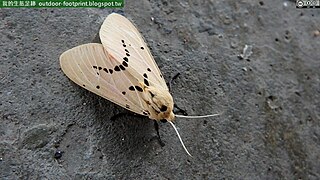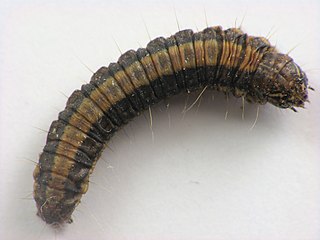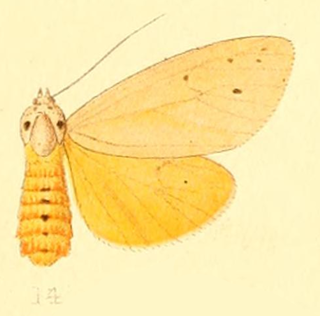
The buff ermine is a moth of the family Erebidae. It is sometimes placed in the genus Spilosoma. The species was first described by Johann Siegfried Hufnagel in 1766. It is found throughout the temperate belt of the Palearctic region south to northern Turkey, Georgia, Kazakhstan, southern Siberia, eastern Mongolia, Amur Region, China, Korea and Japan.

Eucereon is a genus of tiger moths in the family Erebidae. The genus was erected by Jacob Hübner in 1819.
Siccia is a genus of moths in the family Erebidae. The genus was erected by Francis Walker in 1854.

Spilarctia is a genus of moths in the family Erebidae. The genus was erected by Arthur Gardiner Butler in 1875.

Laelia is a genus of tussock moths in the family Erebidae. The genus was described by Stephens in 1828. Species are well distributed throughout Europe, Japan, China, India, Sri Lanka, Myanmar and Java.

Bombycomorpha bifascia, the pepper-tree caterpillar, is a moth of the family Lasiocampidae, which is native to southern Africa.

The Chrysauginae are a subfamily of snout moths. They are primarily Neotropical and include about 400 described species.

The Epipaschiinae are a subfamily of snout moths. Almost 600 species are known today, which are found mainly in the tropics and subtropics. Some occur in temperate regions, but the subfamily is apparently completely absent from Europe, at least as native species. A few Epipaschiinae are crop pests that may occasionally become economically significant.
Spilarctia rhodochroa is a moth in the family Erebidae. It was described by George Hampson in 1916. It is found on Java in Indonesia.
Spilarctia hypogopa is a moth in the family Erebidae. It was described by George Hampson in 1907. It is found on Peninsular Malaysia, Sumatra and Borneo. The habitat consists of lowland forests and secondary vegetation.
Spilarctia phaea is a moth in the family Erebidae. It was described by George Hampson in 1901. It is found on Bali in Indonesia.
Spilarctia albicornis is a moth in the family Erebidae. It was described by George Hampson in 1900. It is found in Sri Lanka.
Spilarctia castanea is a moth in the family Erebidae. It was described by George Hampson in 1893. It is found in Sri Lanka.
Spilarctia coccinea is a moth in the family Erebidae. It was described by George Hampson in 1907. It is found in the Philippines.
Spilarctia longiramia is a moth in the family Erebidae. It was described by George Hampson in 1901. It is found on Java and Sumatra.

Spilarctia metaxantha is a moth in the family Erebidae. It was described by George Hampson in 1901. It is found in Myanmar.







